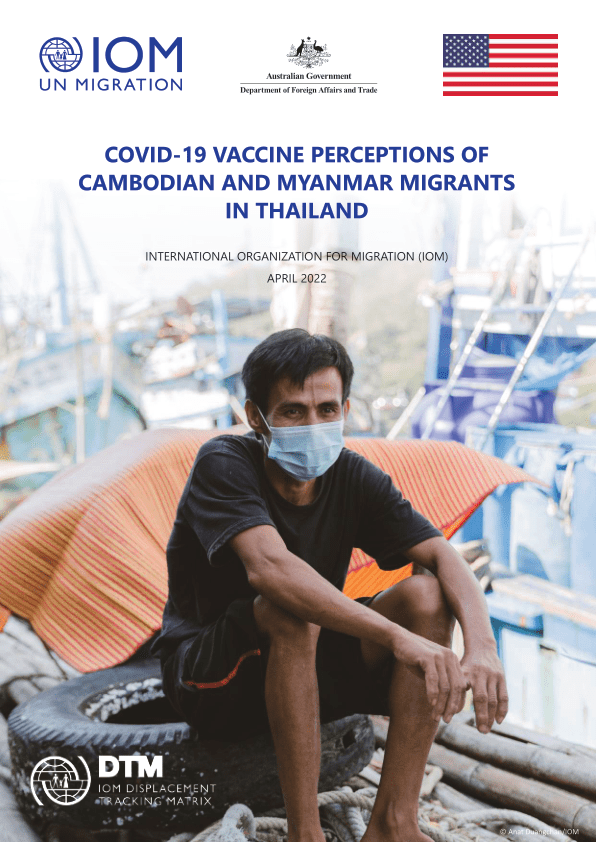EXECUTIVE SUMMARY
Migrant Profiles
A total of 4,431 respondents were surveyed for this assessment, of whom 64 per cent identified themselves as Myanmar nationals and 36 per cent as Cambodian nationals. Females (53%) represented the majority of the sample population.
A higher proportion of respondents were married (68%), and more than half of respondents reported that they have children (69%). The average household size is 3.6. On average, 41 per cent of respondents have completed primary education. More than half of the total respondents reported residing in Thailand for more than nine years. A majority of respondents reported being employed (78%) on a daily wage basis (63%). Agricultural (18%), construction (15%), and manufacturing (15%) were the most commonly reported sector of employment. Pink card (31%) was the most common type of document respondents held.
COVID-19 Vaccine Perception
Overall, 18 per cent of respondents reported that they or someone in their household tested positive for coronavirus.
Cambodian respondents (26%) reported higher rates of COVID-19 infection compared to Myanmar respondents (13%). The highest percentage of respondents who reported testing positive for COVID-19 were working in the manufacturing sector (19%). Almost half of the total respondents (49%) reported being very concerned about getting COVID-19. Sixty-seven per cent of respondents were fully vaccinated at the time of the survey, 15 per cent received one dose, and 18 per cent were unvaccinated. The majority of vaccinated respondents are between 35 and 44 years. Myanmar respondents accounted for 60 per cent of vaccinated respondents. Almost half of the unvaccinated respondents (42%) did not have any education. The majority of unvaccinated respondents (40%) worked in agriculture, while 68 per cent of those who received at least one vaccine dose worked in construction. One in two unvaccinated respondents reported having no documents living in Thailand.
Almost all the respondents (96%) who are unvaccinated were aware of the availability of vaccines in Thailand. Although a higher proportion of the respondents were willing to receive the vaccination when one became available, almost onethird of unvaccinated respondents were hesitant or refused to get vaccinated against COVID-19. Vaccine willingness differed between male and female respondents, with male respondents (35%) reporting that they are hesitating or less willing to be vaccinated. A relatively higher rate of hesitation and refusal to be vaccinated against COVID-19 were found among Myanmar respondents (20%) compared to Cambodian respondents (5%). Respondents who worked in construction (82%) were more likely to get a vaccinate when one becomes available, while almost half (49%) of the respondents who worked in wholesale retail and trade indicated a hesitancy or unwillingness to vaccinate. Respondents who are not willing to receive the vaccination reported that the COVID-19 vaccine is unnecessary because they are already healthy (45%), and concerns regarding pre-existing chronic disease (39%) are some of their primary reasons for not wanting to get vaccinated. On the contrary, the most commonly reported reasons for vaccine acceptance were the effectiveness of vaccination in preventing COVID-19 (57%), a mandatory vaccination policy by employers (42%), and resuming travel (41%).
Access to COVID-19 Vaccine Information
The main sources of information about COVID-19 vaccines, reported by respondents, were family or friends (66%), word of mouth (50%), and employers (34%). Seventy-two per cent of the overall respondents reported that COVID-19 vaccine information and communication materials are not being distributed in their areas, while 23 per cent reported receiving the materials from the Thai government (61%) and NGOs, CBOs, or UN (31%). The information being distributed mainly covers COVID-19 prevention measure and hygiene (86%), COVID-19 vaccine registration and eligibility details (32%), information about the vaccine (17%), and vaccine safety and potential side effects (17%).
Among respondents who reported receiving the materials, almost one-third reported that information is difficult
to understand due to their inability to read the written information provided. A majority (79%) of the respondents
ranked their ability to read Thai at the lowest level of the scale. Types of COVID-19 vaccine information reported
by respondents as being most needed were COVID-19 vaccine safety and potential side effects (54%), information
about the vaccine (48%), and information about what to do before, during, and after getting the COVID-19 vaccine
(36%).
COVID-19 vaccine perceptions of Cambodian and Myanmar migrants in Thailand (April 2022)

Laisser un commentaire